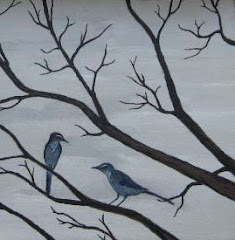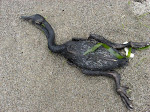
I keep a nest journal for my own reference and I enter data from the journal into spreadsheets to back up the information.

When I am observing nests and I do not have a research permit, I act as noninvasive as possible by refraining from handling eggs or nestlings, and I do not intentionally flush incubating adults. After five years of working on nesting studies where detailed information was valued at any price, it was hard to break the above habits, but I’m trying to set a good example for amateur naturalists.
For me, every nest is an opportunity for to learn more about its builders. A found nest is also an opportunity to collect data that could be of future use to others. Timing of nesting behaviors is probably the most valuable data I can collect. I expect climate change will have a big impact on reproductive timing and I hope to help document the magnitude of these effects. I am also interested in nest survival estimation methods. Most established techniques require handling eggs and flushing adults to obtain a good estimate of nest survival. In the coming years, I plan to look for a lot of American robin and bushtit nests to develop less-invasive techniques.
During the winter months when I am not busy with nests, gulls occupy the void left in my brain. At least ten species of gulls can be spotted in western Oregon in winter and it has been quite a challenge to identify them all. Gull watching requires much patience and research and I consider it a completely separate hobby from birding. Learning the molts, hybridization, delayed plumage maturation, and feather fading patterns of these birds can cause headaches for many, but it keeps me busy during the dark and rainy winter hours.

I also keep a gull journal, in which I document my sightings which I hope to someday use to identify patterns in occurrence and abundance of our winter visitors.
I had not had the opportunity to collect gull data from inside our apartment since our window does not face typical gull haunts such as lakes, parking lots, or city parks. Yesterday, however, I watched a pair of gulls perch on the roof of the building outside my window. I couldn’t get a photo with our dinky camera, so you will have to take my word that one was an adult western gull and the other a first-winter western gull. This species does not stray from coast as frequently as their glaucous-winged cousins, so they are always a welcome sighting. Most of the birds I see near the apartment are glaucous-winged gulls, glaucous-winged hybrids, or ring-billed gulls. If I wander farther to some large parks, I may find California gulls and the smaller mew gulls, my wife’s favorite.






No comments:
Post a Comment